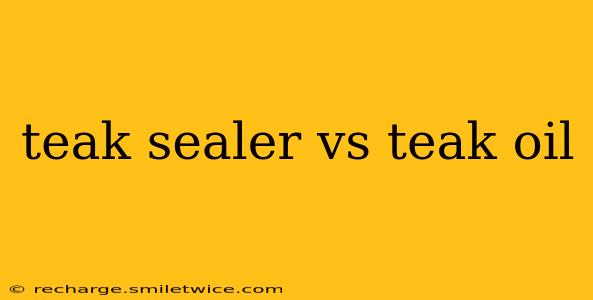Teak wood, renowned for its durability and rich golden hue, requires proper maintenance to preserve its beauty and longevity. Choosing between teak sealer and teak oil is a crucial step in this process, and understanding their differences is key to making the right decision for your teak furniture, decking, or boat. This guide will delve into the specifics of each product, highlighting their pros and cons to help you choose the best option for your needs.
What is Teak Sealer?
Teak sealer is a protective coating designed to create a barrier against the elements. It forms a film over the teak wood, preventing water, UV rays, and other environmental factors from penetrating the surface. This protection significantly reduces weathering and graying, helping to maintain the teak's natural color for longer.
Advantages of Using Teak Sealer:
- Superior Protection: Sealers offer a more robust barrier against moisture and UV damage than oils. This is especially beneficial in harsh climates.
- Longer Lasting: A good quality sealer can last for several years before requiring reapplication, reducing the frequency of maintenance.
- Maintains Color: By blocking UV rays, sealers help prevent the wood from fading and graying, preserving its rich color.
- Easy Application: Many sealers are easy to apply with a brush, roller, or sprayer.
Disadvantages of Using Teak Sealer:
- Can Alter Appearance: Some sealers can alter the natural look and feel of the teak, giving it a slightly glossier or more artificial appearance.
- Requires More Thorough Preparation: The surface needs to be meticulously cleaned and prepared before sealing to ensure proper adhesion.
- More Difficult to Remove: Removing a sealer requires more effort than removing oil, often involving sanding or stripping.
What is Teak Oil?
Teak oil, often a blend of various oils (not always pure teak oil), penetrates the wood, nourishing and protecting it from within. It doesn't form a surface film like a sealer but instead enriches the wood fibers, enhancing their water resistance and durability.
Advantages of Using Teak Oil:
- Natural Look & Feel: Teak oil maintains the natural appearance and feel of the wood, allowing its grain and texture to shine through.
- Enhances Wood: It penetrates the wood, nourishing and enhancing its natural beauty.
- Easier Application & Removal: Oil is generally easier to apply and remove than sealer.
- Better for Small Cracks: Teak oil can penetrate small cracks and crevices, offering protection where a sealer might not reach.
Disadvantages of Using Teak Oil:
- Less Protection: Teak oil offers less protection against the elements compared to a sealer, especially in harsh conditions.
- Requires More Frequent Application: It needs more frequent reapplication, usually annually or even more often depending on the climate and use.
- Can Become Slippery: Oiled teak surfaces can become slippery when wet.
- May Attract Dirt: The oil can attract dirt and grime, requiring more frequent cleaning.
Which is Right for You? Teak Sealer or Teak Oil?
The best choice depends on your priorities and the specific application:
-
Choose teak sealer if: You prioritize long-lasting protection, want to minimize maintenance, and are less concerned about maintaining a completely natural look. This is ideal for decking, exterior furniture that's exposed to harsh weather, or boat decks.
-
Choose teak oil if: You want to preserve the natural beauty and feel of the teak, are willing to perform more frequent maintenance, and value a more natural approach. This is suitable for indoor furniture, less exposed outdoor furniture, or applications where a completely natural look is preferred.
How Often Should You Reapply Teak Sealer or Oil?
Teak Sealer: Reapplication frequency varies depending on the product and environmental conditions. High-quality sealers can last for several years, while others may require reapplication every 1-2 years. Check the manufacturer's instructions for specific recommendations.
Teak Oil: Teak oil usually requires annual or even more frequent reapplication, particularly in areas with high sun exposure, rain, or humidity. Regular inspection is crucial; reapply when the wood looks dry or feels rough.
Can You Use Teak Sealer and Teak Oil Together?
While not typically recommended, it's possible to use both products, although the order and timing are crucial. Applying sealer over oil is generally not effective as the oil will prevent proper sealer adhesion. Applying oil over sealer is possible but will reduce the sealer's effectiveness. It's best to choose one or the other for optimal results.
By understanding the key differences between teak sealer and teak oil, you can make an informed decision to protect and preserve your valuable teak wood for years to come. Remember to always follow the manufacturer's instructions for application and maintenance.
